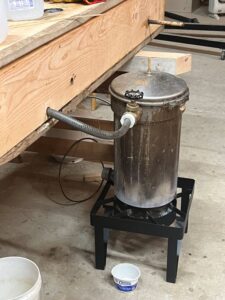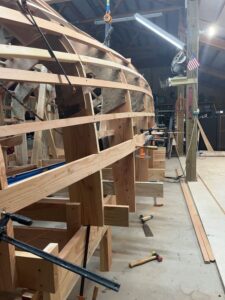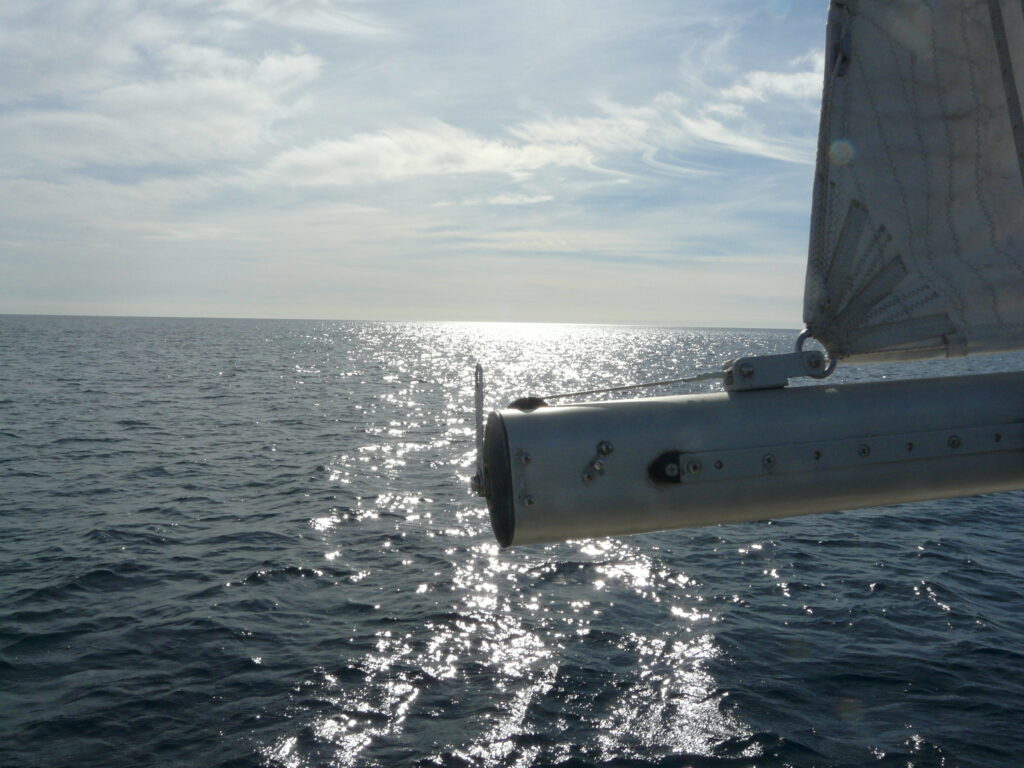“Ward Thee Well, Theresa II.
I, Your Little Ship Will Rip Asunder.
Dark Eyes, Swirling Skies
Your Doom Lies With Light And Thunder.”
These booming words came to me in the dark, vile and odious, leaving a knot of coldness in my stomach where a thread of hope had until now survived. I was already on an edge as I had spent a day with little to eat and a bit seasick. Now the air was thick and heavy with a tinny smell of ozone. It was black as pitch on deck and nothing more could be done. It was death to be out there. If only everything would stop rattling. I tumbled down the companionway into the galley, grabbing a stack of crackers. I had to eat something. I was exhausted. Fear was at the gate. My old familiar friend. When I closed my eyes, I could see him grinning, sharp yellow teeth, gnarled fingers reaching toward me. It was my curse that I had once let him in and now he knew me. I wedged myself in my bunk between the hull and an extra mattress and closed my eyes to get some sleep. It was 0200 and this was going to be a tough night.
“You will fail!” roared the creature at the gate. “I will take you in the end and all your efforts will not avail!”
I shut my eyes tightly, driving him out. Thought of the Last few days, the decisions I had made that placed me here. The trip so far had been amazing. I was five days out from Tuvalu bound for Vanuatu and a little more than three months since leaving Panama. I had decided to go it alone, as no one would come with me. So here I was. Now though, I was in it. At 1100 I had taken in the last reef and now had only a small trysail out. I had deployed the drogue and we were drifting southwest toward the middle Vanuatu Islands at about a knot. I had no idea what the wind speed was as everything on my masthead was gone. When I left the cockpit the force of the wind was shearing off the tops of the waves, making visibility nearly zero. Getting the drogue out had drained my strength. Best to wait it out, I thought. Most of these islands are surrounded by fringing reefs. Better here than there, for now. My AIS was still working and there were no ships nearby, the only good news I could think of. I am no good at judging wave height but I can tell you that from the cockpit, when in a trough, I had to look up at about 20 degrees to see the top of one. Four to five meters I had to guess. As I laid in my bunk, for the hundredth time, I mentally calculated my drift and the time I had before I hit the reefs, probably near Efate. Surely this weather would blow out before then. I gripped the bulkhead behind my pillow as we shuddered again down a big one, started to broach until the big drogue jerked and pulled us back to safety.
“Your miserable state is appealing to me.” The creature laughed with a scream that filled me with dread. “You are mine this night and I will take you for sure as you lie stupidly in your bed.”
I feverishly set about once again calculating my drift. I worked some trig problems. I calculated how many hits with a one-eighth inch punch to cut out a three-inch circle. Creature be damned. Suddenly Mike, my old boss, was there. He was dressed in a suit sitting on the other settee eating a Caesar salad with croutons on it.
I sat up startled and said, “Mike! Sorry Mike, “as I handed him my letter of resignation. “I’ve done my job here but now I have to go. I’m bored to death and I want to retire.”
He looked at me in disbelief. “You are Supreme Allied Commander! No Dave, you cannot go. I need you here.”
“But I’m going to build a house and then I’ll build a boat. No wait, I already built the house.”
And then the creature across from me morphed into a black smoldering pyre of tar. And on top of this pyre sat my little ship with fire in its portlight eyes and a cavernous hole for a mouth. And from out of the mouth came notes of a tune of such beauty and astounding complexity that I was lulled into simply listening. The noise of the storm and the rattling ceased and all I heard was a vaguely familiar whistling and plucking of the most fascinating music I have ever heard. And with the last note I heard a resounding CRACK! up on the deck and the creature roared with laughter. I rushed to suit up and, grabbing my harness and a light, I undogged the hatch and clamored up on deck expecting to see the mast in the water. The weather had not changed but the mast was still there. Clipping onto the jack line I inched forward on all fours. The noise and the wind were deafening. Everything on the boat was rattling and trying to tear itself loose. As I wrapped my arms around the mast I began to survey for damage. I soon noticed a plank along the sheer that looked like it had sprung. What? How could that happen? That’s the last thing I would expect. But as I took this in, I realized it wasn’t the plank I was looking at but the beam shelf under it. It had been under such tension it had sprung itself loose and knocked a hole right through the upper hull on my little ship. And as I stood there trying to reason how this could happen and what on earth I could do, the entire beam shelf ripped out of the hull with a loud TWANG and flung itself high up into the sky like a piece of spaghetti in the wind and was gone! What was left behind was a gaping hole about four inches wide and 25 feet long. Into this hole poured water like a flooded storm sewer. As I looked down into the hole there was the creature grinning with sharp yellow teeth and his gnarled fingers reaching out.
I sat up suddenly awake in a cold sweat. “Oh my Gosh!” I exclaimed as I put on my shoes. “I have got to do something to relax that beam shelf. It’s definitely under too much stress.” Walking outside I quickly noticed there were no five-meter seas and the storm had passed. Inside the shop awaited Theresa II, as if nothing had happened. I quickly found my chair and began to line out my strategy on resolving my issues with the beam shelf. Steaming them hadn’t really worked to my satisfaction. Since I really don’t want my beam shelves flying off like a piece of spaghetti (if you can think it, it can happen!), I need to get them to lie on there comfortably. There are many ways to fail when steam bending. The usual ways are not enough steam in the box or not hot enough, not enough time in the box, or too much time in the box. My Coleman stove was good for my smaller box but could not supply enough steam for my bigger one. It took almost an hour to get up to temperature (+200F).

My propane cooker does it in 10 minutes. It takes heat and about an hour and a half of it to do the job, adding water every 20 minutes. Bending a 1.25 x 4-inch timber in three directions has been a challenge. It is not something you can build a form for in order to over bend it and compensate for springback. It’s not something you can laminate out of many layers, as I did the stem and horn timber. Laminating six layers of Douglas fir four inches wide in a complex shape 25 feet long and keeping it all together without voids (by myself) is pretty much impossible. As far as springback goes, laminating would take care of that. (Springback is the measured amount that a piece returns to its original shape after being bent or laminated.) There is actually a formula for calculating this. It is this equation.
100{1/(N^2-1)}
where N is the number of laminations. Multiplying times 100 gives you percentage. So, with six laminations you would get 100(1/6^2-1) or
100(1/35) or 2.9%. If the bend is 1” from the top of the arc to bottom that means only 2.9% springback or in this case, 29 thousandths (.029” = about 1/32”) or about ¾ mm, almost nothing in boat terms. You can also see from this, the way I am doing it, with one lamination, the formula doesn’t even work. With two laminations the result would be 33% or 4”.
There are other factors involved such as thickness of laminations and type of wood which somewhat come into play and that is why this formula is only an estimation. There is also, in the case of a complex bend in many directions, the fact of opposing vectors of force, some of which would reduce overall springback. Nevertheless, this option was nixed long ago. So, there it was. The decision was made and off they went. I stood them up at the far end of the shop in exile, pillars of lost hope, where they glared at me from behind piles of boxes. I found them difficult to look at as I had picked through no less than 100 boards to find these choice pieces. There are other factors involved which may have contributed to their demise; kiln dried vs. air dried lumber, plain sawn vs. quarter or rift sawn, hardwood vs. softwood and moisture content. The moisture content was low at seven percent. (12% to 15% would have been better) Douglas fir is difficult to begin with. They were quarter-sawn. All strikes against me.

The new pieces are plain sawn with a higher moisture content. I have also cut them out of a wider piece and spiled (cut to a measured curve) the more difficult sections at each end. I also think I had loosened the clamps too soon before the lignin in the wood had set after cooling. Though they were still a beast to get all clamped on, working by myself, I can already tell they are more relaxed. I learned, or rather re-learned a few lessons here. The beam shelves are almost installed (again) and it’s time to move on to the next unsolvable problem. Perhaps the real lesson here is not about bending wood, not even about boatbuilding, but in listening to the creature. After all he did warn me and that’s why he is my friend. I only have one regret though. I would like to have seen Vanuatu.
Dave Ahrens


